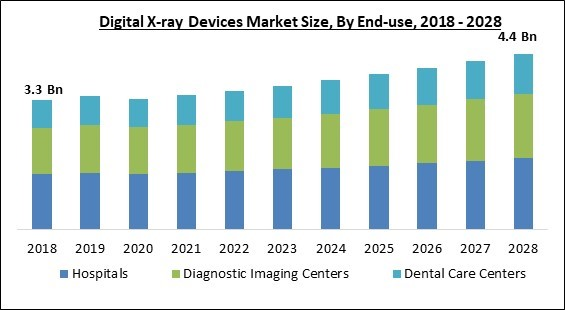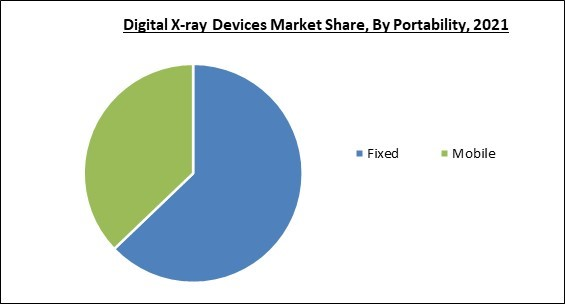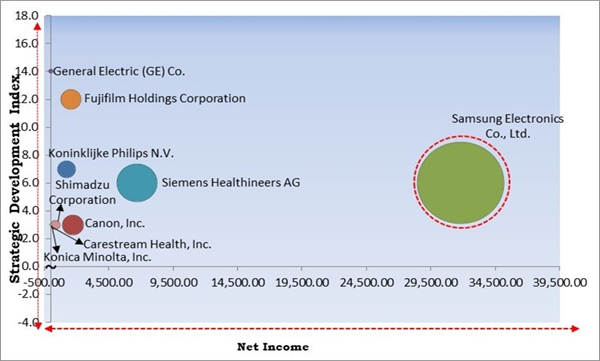The Global Digital X-ray Devices Market size is expected to reach $4.4 billion by 2028, rising at a market growth of 4.0% CAGR during the forecast period.
Digital x-ray devices refer to advanced x-ray devices which produce a digital radiographic image on computers. These X-ray devices comprise sensitive detectors & plates which capture an immediate image while screening and directly transfer it to the computer screen. The digital X-ray serves a range of benefits, including shorter radiation exposure time, improved detail detectability, linearity, and enhanced SNR, as well as the effortless transfer of information to patients & concerned individual electronically.
The digital detector arrays, commonly known as flat panel detectors, enable the user to obtain high-quality digital images better than any other imaging device. They further offer a better signal-to-noise ratio and enhanced dynamic range that results in providing high sensitivity for radiographic applications. These detectors work on two different approaches, that is, direct conversion and indirect conversion.
Indirect conversion offers a scintillator layer that converts x-ray photons into visible light photons and uses a photo diode matrix of amorphous silicon used for eventually converting the light photons into an electrical charge. The charge is proportional to energy & number of X-ray photons that interact with the detector pixel. The utilization of chemicals in technique is linked with occupational health issues and unpleasant odors.
The cost of traditionally used X-ray devices is high in terms of space, money, and time. Digital X-ray devices offer an eco-friendly and high-quality alternative. Decreased exposure to radiation for patients is another advantage of digital X-ray devices over traditional X-ray devices. Digital & analog imaging systems are different when considering image production and display patterns. Digital X-ray images use the same rule of physics as conventional imaging systems. Digital images are visualized directly on a PC instead of viewing a photographic film by using a lightbox.
The major strategies followed by the market participants are Product Launches. Based on the Analysis presented in the Cardinal matrix; Samsung Electronics Co., Ltd. is the major forerunner in the Digital X-ray Devices Market. Companies such as Siemens Healthineers AG, Canon, Inc. and Koninklijke Philips N.V. are some of the key innovators in Digital X-ray Devices Market.
The market research report covers the analysis of key stakeholders of the market. Key companies profiled in the report include General Electric (GE) Co. (GE Healthcare), Siemens Healthineers AG (Siemens AG), Koninklijke Philips N.V., Canon, Inc. (Canon Medical Systems Corporation), Carestream Health, Inc. (Onex Corporation), Fujifilm Holdings Corporation, Mindray Medical International Limited, Shimadzu Corporation, Samsung Electronics Co., Ltd. (Samsung Group) (Samsung Medison Co., Ltd.), and Konica Minolta, Inc.
Digital x-ray devices refer to advanced x-ray devices which produce a digital radiographic image on computers. These X-ray devices comprise sensitive detectors & plates which capture an immediate image while screening and directly transfer it to the computer screen. The digital X-ray serves a range of benefits, including shorter radiation exposure time, improved detail detectability, linearity, and enhanced SNR, as well as the effortless transfer of information to patients & concerned individual electronically.
The digital detector arrays, commonly known as flat panel detectors, enable the user to obtain high-quality digital images better than any other imaging device. They further offer a better signal-to-noise ratio and enhanced dynamic range that results in providing high sensitivity for radiographic applications. These detectors work on two different approaches, that is, direct conversion and indirect conversion.
Indirect conversion offers a scintillator layer that converts x-ray photons into visible light photons and uses a photo diode matrix of amorphous silicon used for eventually converting the light photons into an electrical charge. The charge is proportional to energy & number of X-ray photons that interact with the detector pixel. The utilization of chemicals in technique is linked with occupational health issues and unpleasant odors.
The cost of traditionally used X-ray devices is high in terms of space, money, and time. Digital X-ray devices offer an eco-friendly and high-quality alternative. Decreased exposure to radiation for patients is another advantage of digital X-ray devices over traditional X-ray devices. Digital & analog imaging systems are different when considering image production and display patterns. Digital X-ray images use the same rule of physics as conventional imaging systems. Digital images are visualized directly on a PC instead of viewing a photographic film by using a lightbox.
COVID-19 Impact Analysis
The outspread of novel coronavirus across the globe has adversely affected the world’s economy. The pandemic has presented many challenges to healthcare providers. The pandemic has also affected different stages of the value chain due to strict restrictions and lockdowns imposed by the governments of several nations. In addition, the turnaround time for product and service delivery has been affected negatively because of newer packaging protocols defined by authorities in consideration of COVID-19. Due to all these factors, the digital x-ray devices market has been negatively affected as a result of disrupted manufacturing and supply chains.Market Growth Factors
Continuous Advances in Technology & Product Development
Technological advancements are an important factor driving the growth of the digital x-ray device market. The demand for technologically advanced digital X-ray systems rises because of advantages such as the ability to process a vast volume of data and examine patients rapidly. Various market players are offering digital systems having the latest technologies to improve their performance and efficiency. These systems allow the users to address a wide range of applications with stitching functionality and diagnostic-quality images.Rising Prevalence of Chronic Disorders
The incidence of severe orthopedic issues is rising across the globe. Orthopedic disorders are evolving as a major concern over public health. The increasing occurrence of osteoporotic fractures, osteoarthritis, carpal tunnel syndrome, and rheumatoid arthritis are some of the factors that contribute to the concern. The growing number of obese people in the region is the primary factor responsible for these rising cases of orthopedic disorders.Market Restraining Factors
Digital X-Ray Systems Are Usually Expensive
Digital x-ray devices are available at premium prices and need a high amount to be invested while installation. This increases the overall procedural cost for patients as well. This high cost significantly affects the adoption of new systems equipped with advanced and expensive technologies. Most of the small and medium-sized hospitals could not afford these systems, as they have low budgets.Portability Outlook
Based on portability, the digital X-ray devices market is segmented into fixed, and mobile. The fixed segment dominated the digital X-ray devices market with the maximum revenue share. These types of x-ray systems need a transformer of large size, which is required to be built into the room. The demand for this type of x-ray device is majorly rising in developing nations with relatively slow adoption of the latest technologies.Application Outlook
On the basis of application, the digital X-ray devices market is fragmented into general imaging, orthopedic, dental and mammography. The dental segment covered a significant revenue share in the digital X-ray devices market in 2021. Acquiring dental X-rays is the most frequent practice carried out in dental clinics. Dental X-ray offers various advantages in dentistry, including the capability to identify the presence of infection and diagnose cavities and impacted teeth.End-USe Outlook
By end use, the digital X-ray devices market is divided into hospitals, diagnostic imaging centers and dental care centers. In 2021, the diagnostic imaging centers segment procured a remarkable revenue share in the digital X-ray devices market. The hospitals offer various departments, but diagnostic imaging centers focus only on imaging services that provide the patients with an individualized experience. Also, these centers provide same-day appointments, which eliminate the need for long waiting times as required in hospitals.Regional Outlook
Region wise, the digital X-ray devices market is analyzed across the North America, Europe, Asia Pacific and LAMEA. In 2021, the North America region led the digital X-ray devices market by generating the highest revenue share. This is because of the presence of key market players in the region and favorable investment policies offered by the government. In addition, the governments in the North American nations are raising their expenditure on the development of cutting-edge medical equipment, which would support the growth of the regional digital X-ray devices market.The Cardinal Matrix - Digital X-ray Devices Market Competition Analysis
The major strategies followed by the market participants are Product Launches. Based on the Analysis presented in the Cardinal matrix; Samsung Electronics Co., Ltd. is the major forerunner in the Digital X-ray Devices Market. Companies such as Siemens Healthineers AG, Canon, Inc. and Koninklijke Philips N.V. are some of the key innovators in Digital X-ray Devices Market.
The market research report covers the analysis of key stakeholders of the market. Key companies profiled in the report include General Electric (GE) Co. (GE Healthcare), Siemens Healthineers AG (Siemens AG), Koninklijke Philips N.V., Canon, Inc. (Canon Medical Systems Corporation), Carestream Health, Inc. (Onex Corporation), Fujifilm Holdings Corporation, Mindray Medical International Limited, Shimadzu Corporation, Samsung Electronics Co., Ltd. (Samsung Group) (Samsung Medison Co., Ltd.), and Konica Minolta, Inc.
Strategies Deployed in Digital X-ray Devices Market
Partnerships, Collaborations and Agreements:
- Apr-2022: GE Healthcare came into partnership with Unilabs, a provider of diagnostic services in Europe. Under this partnership, CT scanning technology, mammography, MRIs and X-ray machines, and innovative imaging fleet services would be delivered to Portugal. This would strengthen GE Healthcare’s vision of making healthcare more precise, personalized, and efficient.
- May-2021: Fujifilm partnered with Qure.ai, a health tech startup utilizing artificial intelligence assistance for medical imaging diagnostics. The partnership augmented intelligent X-ray solutions with qXR*1 (software). This software application is created with deep-learning artificial intelligence technology. Moreover, the partnership supports the expansion of TB screening in India.
Product Launches and Product Expansions:
- Oct-2022: Samsung introduced AccE Glass-Free Detector for X-Ray Imaging that provides an unparalleled imaging experience because of its lightweight design.
- Aug-2022: GE Healthcare announced the launch of Definium 656 HD, the next-generation advanced fixed X-ray system. The system provides consistent, efficient, and highly automated exams that are beneficial for radiology departments. Definium 656 HD is a digital and versatile radiographic system with the latest Helix 2.2 advanced image processing software and GE’s FlashPad HD high-resolution detectors.
- Jul-2022: Siemens Healthineers unveiled Mobilett Impact, a mobile X-Ray System. This system integrates the benefits of a mobile X-ray system for imaging at the patient’s bedside with full digital integration and an economical price. Additionally, it can make the complete imaging workflow right at the patient's bedside.
- Jul-2022: Shimadzu Medical Systems launched the MobileDaRt Evolution MX8 Version V type that can be shifted to the location easily where an X-ray examination is required.
- Jul-2022: Fujifilm Europe announced the launch of FDR Cross, a hybrid C-arm and portable X-ray device. This device is designed to provideing high-quality static and fluoroscopic X-ray images during medical procedures and surgeries.
- Apr-2022: Samsung Digital Radiography and Ultrasound Systems released the GM85 Fit, a new configuration of the premium AccE GM85, a digital radiography device. This features a user-centric design that supports effective and efficient patient care.
- Mar-2022: Konica Minolta introduced AeroDR TX m01, a mobile X-ray system having a wireless dynamic digital radiography function in Japan. This system is used at the bedside in hospital wards, intensive care units (ICUs), and operating rooms.
- Feb-2022: Carestream Health India released the DRX Compass, a convenient, configurable, and accurate digital radiology solution. This solution has been designed for delivering a new level of efficiency to radiologists and provides the versatility for building the required configuration from a vast range of selections in tubes, detectors, collimators, and generators, offering complete control on how to use future-proof digital radiology technology to radiologists.
- Sep-2021: GE Healthcare launched the AMX Navigate, a new portable, digital X-ray system. This system is designed with a first-of-its-kind power-assisted Free Motion telescoping column, which decreases the lift force by around 70 percent and reduces technologist injury. Moreover, this system's small footprint smoothens enhanced maneuverability and easy positioning, even in busy spaces.
- Sep-2021: GE Healthcare introduced a digital X-ray system, Definium Tempo. The system minimizes the workflow burden and enhances the productivity of radiology departments. Definium Tempo's tube-mounted console has functionalities for protocol selection, patient selection, positioning setup, and technique modification.
- Mar-2021: Fujifilm unveiled FDR Nano, the mobile digital radiology system. This system has high-resolution imaging with low X-ray doses in healthcare setups and provides a wide platform beyond X-ray department e.g. ORs and ERs where quick decisions are the need of saving the life of critical patients.
- Nov-2020: Siemens Healthineers announced the launch of the MULTIX Impact C Ceiling-Mounted Digital Radiography System. This system has an intuitive operating system, motorized tube heads, versatile wireless detectors, and a free-floating, flat tabletop for making patient access easy.
- Nov-2020: Canon Medical introduced the OMNERA 500A Digital Radiography System. This system enables facilities to access high productivity for imaging departments so that they can focus on patients. The system comprises new intelligent automation features for increasing workflow and efficiency, without compromising patient care.
- Jun-2020: GE Healthcare released the Thoracic Care Suite, a suite of eight AI algorithms from Lunit INSIGHT CXR. This suite helps in reducing clinical pressure because of COVID-19. This suite analyses chest X-ray findings fastly indicates abnormalities for review by radiologists.
Acquisitions and Mergers:
- Jul-2021: Fujifilm Healthcare completed the acquisition of Hitachi Diagnostic Imaging. The acquisition enhanced Fujifilm's product and services in various areas of diagnosis and prevention for European patients by integrating Fujifilm's expertise in CT, MRI, and ultrasound with Hitachi's core capabilities in x-ray, endoscopy, women's health, AI, PACS, and IVD.
- Jan-2021: Philips acquired Capsule Technologies, Inc., a provider of vendor-neutral medical device information platform with a software-as-a-service business model. The acquisition expanded the company's expertise in patient care management solutions for hospitals. Moreover, this acquisition complemented Philips' objective of transforming healthcare delivery.
Scope of the Study
By End-use
- Hospitals
- Diagnostic Imaging Centers
- Dental Care Centers
By Portability
- Fixed
- Mobile
By Application
- General Imaging
- Orthopedic
- Mammography
- Dental
By Geography
- North America
- US
- Canada
- Mexico
- Rest of North America
- Europe
- Germany
- UK
- France
- Russia
- Spain
- Italy
- Rest of Europe
- Asia Pacific
- China
- Japan
- India
- South Korea
- Singapore
- Malaysia
- Rest of Asia Pacific
- LAMEA
- Brazil
- Argentina
- UAE
- Saudi Arabia
- South Africa
- Nigeria
- Rest of LAMEA
Key Market Players
List of Companies Profiled in the Report:
- General Electric (GE) Co. (GE Healthcare)
- Siemens Healthineers AG (Siemens AG)
- Koninklijke Philips N.V.
- Canon, Inc. (Canon Medical Systems Corporation)
- Carestream Health, Inc. (Onex Corporation)
- Fujifilm Holdings Corporation
- Mindray Medical International Limited
- Shimadzu Corporation
- Samsung Electronics Co., Ltd. (Samsung Group) (Samsung Medison Co., Ltd.)
- Konica Minolta, Inc.
Unique Offerings
- Exhaustive coverage
- The highest number of Market tables and figures
- Subscription-based model available
- Guaranteed best price
- Assured post sales research support with 10% customization free
Table of Contents
Chapter 1. Market Scope & Methodology
Chapter 2. Market Overview
Chapter 3. Competition Analysis - Global
Chapter 4. Global Digital X-ray Devices Market by End-use
Chapter 5. Global Digital X-ray Devices Market by Portability
Chapter 6. Global Digital X-ray Devices Market by Application
Chapter 7. Global Digital X-ray Devices Market by Region
Chapter 8. Company Profiles
Companies Mentioned
- General Electric (GE) Co. (GE Healthcare)
- Siemens Healthineers AG (Siemens AG)
- Koninklijke Philips N.V.
- Canon, Inc. (Canon Medical Systems Corporation)
- Carestream Health, Inc. (Onex Corporation)
- Fujifilm Holdings Corporation
- Mindray Medical International Limited
- Shimadzu Corporation
- Samsung Electronics Co., Ltd. (Samsung Group) (Samsung Medison Co., Ltd.)
- Konica Minolta, Inc.
Methodology

LOADING...











